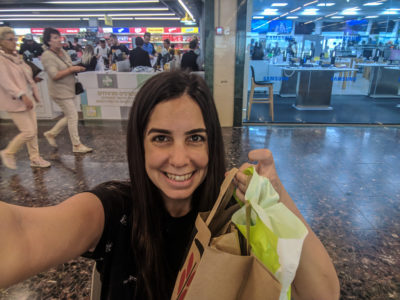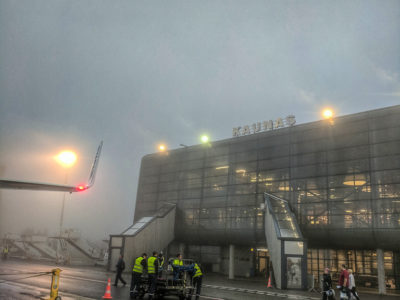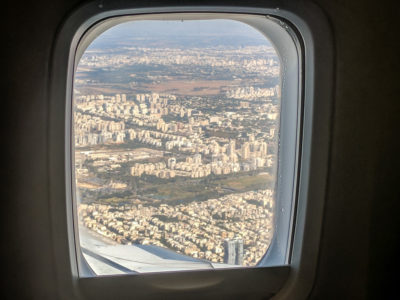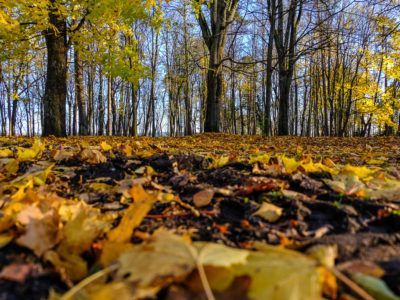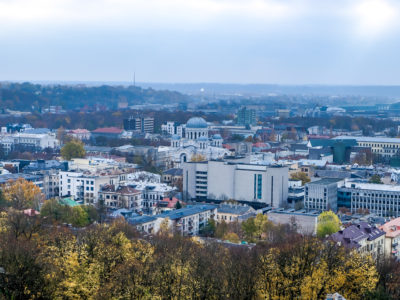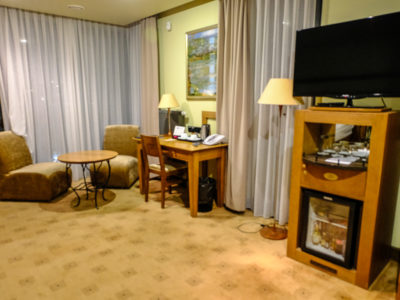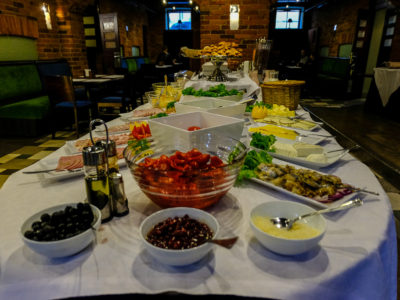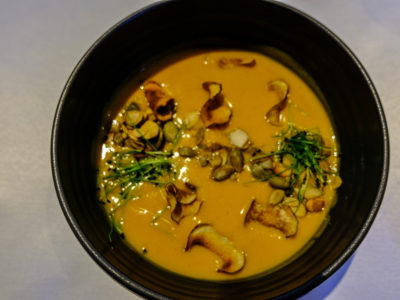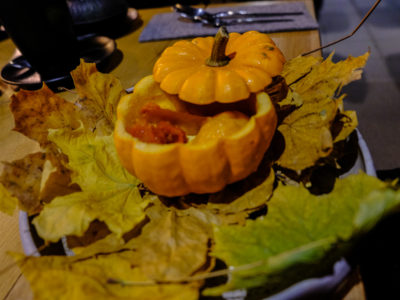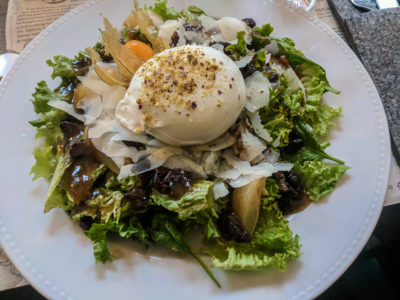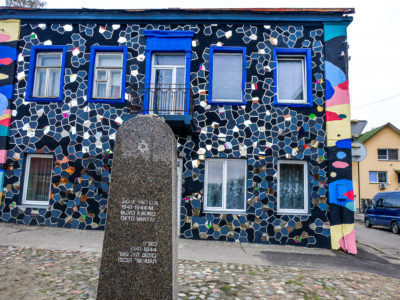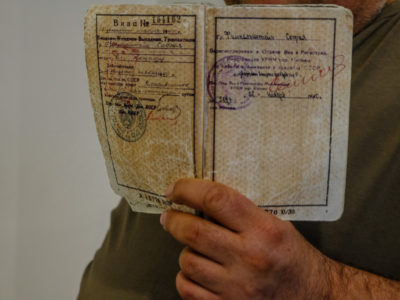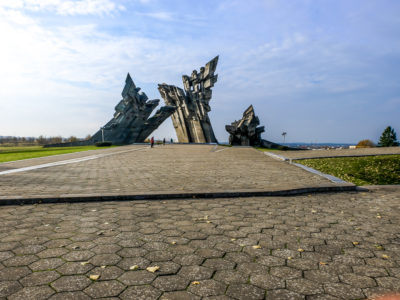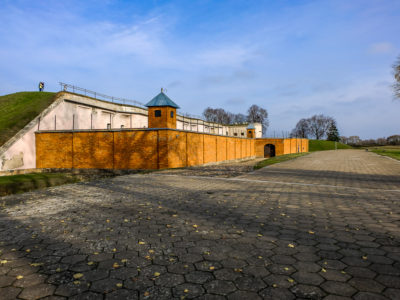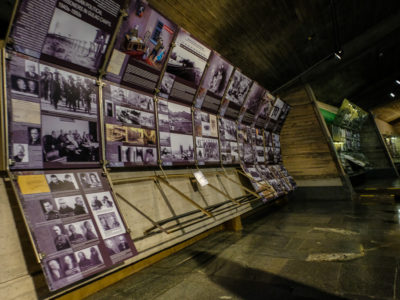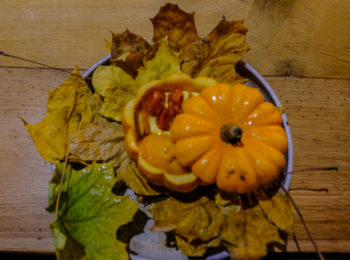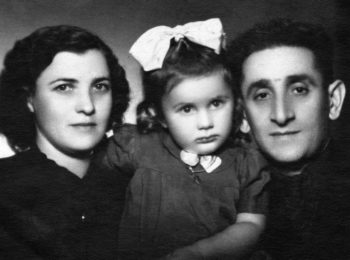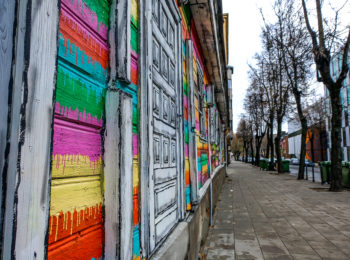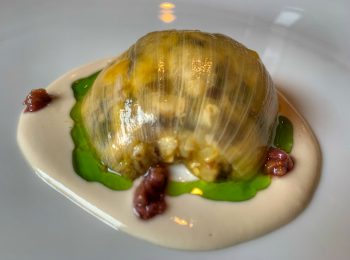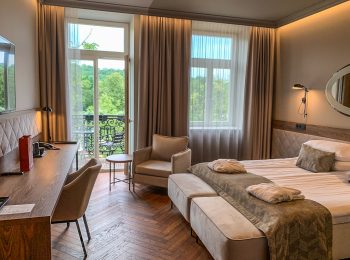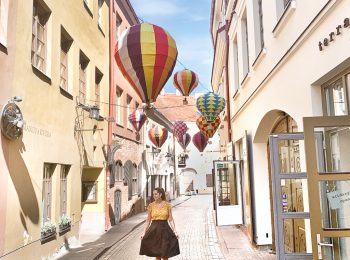I must admit I didn’t know much about Kaunas before Michal (A fellow travel blogger) reached out to me and invited me to join her on a trip to Kaunas, Lithuania – a trip she was invited to by the city’s office of tourism.
After her offer, I of course googled the city looking for information and came across pictures and details about the city that made me want to go and explore it. It looked like a city with fascinating history (Jewish history too), with beautiful architecture and street art. After making sure the dates fit my schedule, I told Michal I’ll join her.
I first met Michal at the airport and we hit it off right from the start, and honestly, our trip turned out great (The office of tourism’s itinerary was interesting and well thought out).
A bit about the city Kaunas
Kaunas is the second largest city in Lithuania (After Vilnius, the capital), with around 300,000 inhabitants. It was Lithuania’s capital between 1929 and 1949.
In 2022 it’ll become one of Europe’s cultural capitals and is thus going through a lot of renovation (If you visit it anytime soon you’ll see a large part of the city is under construction and renovation).
The city has a great basketball team, and it’s the pride of the city. Anyone you’ll talk about basketball to there will be enthusiastic about it. Fortunately for us, we were in town during a game against Real Madrid and the Žalgirio Arena gave us game tickets. It was one of the trip’s special experiences (A recommended experience for people who aren’t usually basketball fans, as well, the game has an amazing atmosphere).
Kaunas radiates a feeling of calm and quiet, while also having many great restaurants, cafés, stores, cool avenues, street art, unique museums like the music museum and lovely people.
Getting to Kaunas and preparations
How to reach the city?
I arrived in a flight from Tel Aviv. Until 2018 you had to take a flight to Vilnius and travel from there (It’s 100 km away from Vilnius, so the distance isn’t that long, about an hour by car), but a new Ryanair route opened on 2018 straight to Kaunas (We were on the first flight there. Yay :)). The city is called by different names in different languages, so make sure you search for Kaunas.
Worth mentioning that starting last month (October 2024) there is a new route Ryanair route from Belfast to Kaunas and flights are pretty cheap at about 25 Euros. You can read more on that on the official announcement.
We arrived at the Kaunas airport (IATA code: KUN) and took a cab, which takes about 30 minutes to the city center.
There’s also a bus directly to the city center which takes about the same time. You should look for bus line 29G to Kaunas City. It takes approx. 35 minutes to get with the bus to the first stop in the Old Town (stop name is E. Ožeškienės g.) and 46 minutes to the final stop which is the Kaunas Train Station (stop name is Geležinkelio stotis). A single trip costs 1 Euro, the ticket is bought from the driver in cash and you can find more details on how to purchase it or use it together with the Kaunas City Card along with up-to-date schedules on the official Kaunas Airport website.
You might also get by an International train or bus from other European cities.
Link to flight price comparison.
Sim card
Sim cards may be a frustrating issue in certain cities and countries (Rather pricey and can only be found in communication company stores, with a passport and some identification process). I usually refer to an E-Sim service or recommend opting in an international internet package with the cellular provider.
In Kaunas, however, it was one of the simplest and most worthwhile things. At every kiosk or supermarket, you’ll find a sim card. I bought one with 1GB included for 2 euros!! I used it for four days and it worked great, with reliable reception and speed. It’s really recommended to buy a sim card there instead of paying for an international internet package with your home country cellular provider.
Public transportation in the city
We actually walked for most of our time there, and when not walking, we were with our guide who drove us around by car. I felt that Kaunas isn’t very developed in terms of public transport. There’s no metro or tram, but there is a train (The train is for going to other cities, not traveling in the city ) and you will mostly go by busses, troleybusses and minibuses. In winter – they change the timetables. Best way is to check this website so you can see the routes and real time movement.
A ride costs 1 euro, and you can also buy an electronic ticket in supermarkets and kiosks and charge them with money, that way the rides are cheaper. If you do, look for a sign: “Kauno Viešasis Transportas” (KVT) (Kaunas Public Transport). You can also use your mobile phone for purchasing tickets and validating you rides on the public transport with apps such as Trafi and Žiogas
To the airport we took a cab with a really nice driver called Vildoras, here’s his cell number if you’re looking for a driver to pick you up or return you to the airport: 865-219-699. If you’re into ride-sharing, you can use Bolt app which is quite popular in Kaunas.
Car rental
Additionally, Kaunas’ whole area is supposed to be really beautiful and I think it’s worth spending 3 days in the city, then renting a car and traveling the region or even driving to neighboring countries like Estonia or Latvia. You can search for a rental car via the search engine Papam Papam. Personally, I really like to search through it because it saves me time (instead of going through several websites) and it also has the option of filtering out non-recommended rental companies and they also seem to provide really good online support when you try to contact them for questions.
You can rent a car within the city center – there are rental agencies near the Train Station or rent a car directly at the airport.
When should you visit Kauans?
If you’re looking to really experience the city, I think it’s better to visit during the warm months and not in the cold of winter. The best season is considered to be between the end of April to the beginning of October. However, visiting during December can be great due to the holiday spirit.
Christmas 2024
If you plan to visit Kaunas during Christmas, you can find the city decorated starting November 23rd.
This Christmas in Kaunas features vibrant celebrations, including the iconic Christmas tree in Vienybės Square, a festive market with local crafts, and scenic decorations in the Old Town. Highlights include ice skating and activities at Darius and Girėnas Stadium, live music, and cultural events like exhibitions and film screenings. Don’t miss unique shopping at the Christmas Art Fair on December 7–8 and cozy cafes offering seasonal treats. For more details, visit the Kaunas Christmas page.
Please note that there are lines which change route during the winter.
📣 Wait! Before you keep reading...
I just want you to know that I absolutely love hearing from you! If you've already visited this destination – share your experience in the comments, and if you have any questions or hesitations about planning your trip – I’m totally here for you.
And if you discovered something new along the way – a change in opening hours, a hidden gem worth mentioning, or anything that should be updated – it would really help me (and future readers!) keep this post as accurate and useful as possible 💛
And don’t forget to let me know if this post helped you – nothing makes me happier than knowing I helped you plan an unforgettable trip!
Click here to leave a comment
Additionally, you may rent a bicycle at many locations in town, but those aren’t available during winter. We were on the trip during the end of October and we were lucky, with average temperatures of around 16 Celsius and we got to enjoy the autumn colors which are usually gone by that time.
Local currency
They use Euros in Kaunas since they replaced the Litas (their previous local currency) on 2015 and joined the Eurozone.
Where to stay in town?
We stayed at the Best Western Santakos hotel, a 4-star hotel in a great location!! One of my favorite things about this hotel is its location. It’s right on the border between the new town and the old one, making it the perfect hotel for those looking to explore the city from every direction. We walked nearly everywhere, and it wasn’t too long of a walk.
The hotel is designed in an ancient style (I wasn’t really feeling it as I’m more into the modern style) and its architecture is reminiscent of a castle with winding corridors (I prefer small boutique hotels and was struggling a bit with its sheer size, it always took me a while to find where breakfast was haha). The room itself was spacious, which was fun, especially since I had the room all to myself and an enormous space.
Breakfast was nice, but nothing too unique. It had all the basics like breads, spreads, eggs, sausages, cheeses and pastries, but not of the highest quality.
The hotel also has a sauna and a small roofed pool, which we didn’t have time to visit, but we went to check them out as we saw signs leading there 🙂 The hotel staff was really nice and the hotel and rooms were always clean.
In short, for anyone looking for a hotel in a good location, reasonably priced, I definitely recommend this one (Not the best fit for those looking for a lucrative, boutique hotel).
Here are some up to date reviews on the hotel on TripAdvisor and more reviews and deals on Booking.com.
Recommended restaurants
Kaunas honestly surprised me with the number of good restaurants it has. We got to eat at 7 restaurants, each meal being highly successful, with many more worthwhile restaurants to try (That I’ll definitely try the next time I’m there). I’ve written a detailed post about the restaurants we ate at.
Link to post about restaurants in Kaunas
Judaism in Kaunas
Kaunas has a rich history when it comes to Judaism. Unfortunately, a large part of it is negative, but there are also many fascinating and exciting stories from this town.
The songwriter Leah Goldberg lived in Kaunas. In her youth she studied at the Hebrew Gymnasium, named after Schwaben, in Kaunas, as well as a university in the city. They have a song about her love for the city and Lithuania.
Abraham Mapu, the writer/songwriter, was born in the adjacent town of Vilijampolė (Slobodka). The city has a street named Mapu, after him.
During the holocaust, a pediatrician named Pioters Baurellis from the city’s orphanage, with the help of his team, saved children from the city’s ghetto. The Jews in the ghetto send their babies in potato sacks to the orphanage during the night to save them from the Nazis.
The city also has a museum about the story of Chiune Sugihara, a Japanese diplomat sent to Kaunas for a year and who, as a consul in the city, saved the lives of thousands of jews from Lithuania and Poland by producing visas for them.
The hardest place to visit was the ninth fort. A fort built in the late 19th century to protect the city but was used as a prison before WWII and a concentration camp during the war. 50 thousand people (Most of them Jewish) were murdered there. Today the fort holds a museum, with another museum next to it, portraying the suffering under the Nazis and the Soviets. There is also a large memorial, with several smaller ones around it, for the people murdered there.

